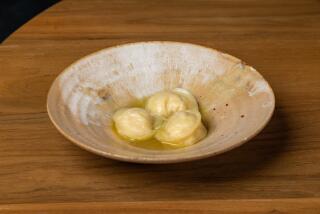Master Class: Chef Michael Cimarusti pries open the basics of clam chowder
- Share via
While testing recipes a few weeks ago, something strange happened. A deep whiff of the Manhattan-style clam chowder I had just made transported me for a brief moment to my grandmother Josephine Cimarusti’s kitchen in Lindenhurst, Long Island. A white-and-green striped sugar bowl with a stainless, hinged, flip-top lid sat on the kitchen table; the scent of clam cakes and chowder filled the air. Perhaps you can relate. We all have foods that we ‘re nostalgic about. For me, chowder is one of them.
These days, chowder is everywhere. American cooks have created countless versions; some bear little or no resemblance to the original. Chowder’s venerable name is kicked about with little regard for its true importance. It’s hard to find a great bowl of chowder no matter if you’re in Augusta or Woonsocket, Astoria or the West Village. I’ve had white chowders as thick and appetizing as spackle and Manhattan chowder a hungry seagull couldn’t pull a clam from.
Every chowder recipe you will find will include two things without fail — or at least they should — onions and salt pork. The earliest versions of chowder would have included finfish over shellfish. Ship biscuits (something like hard tack) were used to thicken them. Early recipes call for salt pork, which differs from bacon mainly because it is not smoked. Potatoes became common in chowders only in the last 150 years or so.
We all think we know that Manhattan-style chowder is tomato-based and New England chowder is cream-based. Dig a little deeper and you’ll find more regional variations. There are also tomato-based chowders that hail from New England, likely due to the large number of Italian and Portuguese immigrants that have crewed the region’s fishing boats for generations.
One of my favorite chowders is the Rhode Island clear. This lesser-known style is made without cream or tomato and is essentially nothing more than clam broth with potatoes, onions and salt pork.
At the briny core of any great chowder is a great clam. I suggest that you use clams in the shell. Quahogs, if you can get them, are preferred, but the more readily available cherrystone will also make a worthy chowder. The first thing to know about shucking a live quahog is that it would prefer not to be shucked. This part of the recipe is a chore, for which I have a solution: your freezer. Place the clams in your freezer for a couple of hours and you’ll find they are much more cooperative.
After a couple of hours in the freezer, the clams should open easily and, while not entirely frozen, the meat will be firm and the juice slushy. Shuck the clams over a bowl to catch all the juice. After shucking the clams, you might find that you need more juice. Never fear: You can augment the fresh juice with canned or bottled clam juice.
Once you have shucked the clams, separate the meat from the juice. Chop the clams, strain the juice through a fine mesh sieve and store the meat and juice separately in the refrigerator until needed.
You should prepare the clams this way regardless of the chowder recipe. Also, you should not add the clams to the chowder itself until just minutes before it is served. This ensures that the clams will not be overcooked and that you’ll also have a fresh full-flavored chowder.
To enjoy any of these soups to their fullest, though, you’ll need to make them a day in advance. Resting the soup overnight will yield a depth of flavor that is not present the day it is made.
To make my favorite chowder (the Rhode Island clear), you’ll need just six ingredients: butter, salt pork, onion, clams, baking potatoes and salt. A classic cream chowder is really just a variation of the clear chowder. Simply reduce heavy cream by half and add it to the clear chowder base. Or you can make the clear chowder, bring the reduced cream to the table and let your guests decide.
Heck, you might even want to make the Manhattan chowder and the reduced cream, mix the two together and create a funky, hybrid pink chowder.
Just don’t tell anybody from Boston or New York where you got the recipe.
Cimarusti is chef-owner at Providence restaurant and the soon-to-open Connie and Ted’s.
More to Read
Eat your way across L.A.
Get our weekly Tasting Notes newsletter for reviews, news and more.
You may occasionally receive promotional content from the Los Angeles Times.










